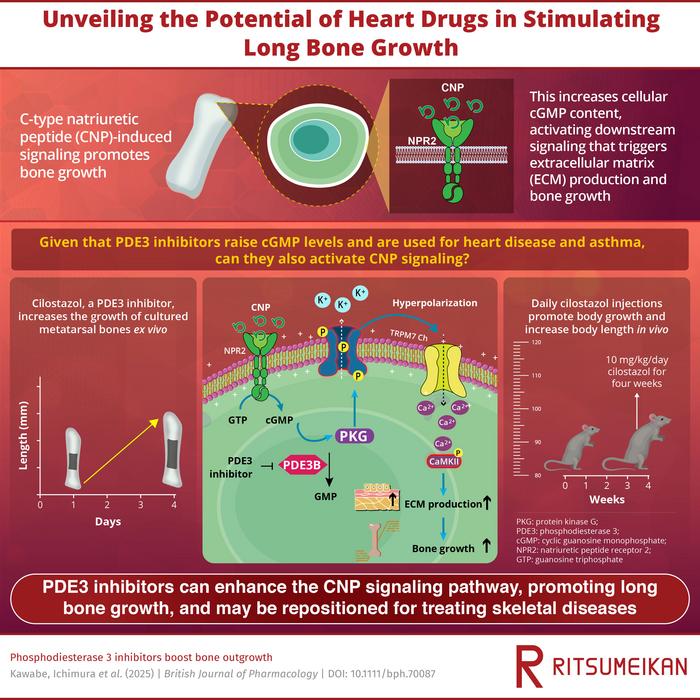
In a groundbreaking new study published in the British Journal of Pharmacology, researchers have identified a remarkable potential repurposing of phosphodiesterase 3 (PDE3) inhibitors—drugs primarily used in the treatment of heart failure, thrombosis, and asthma—to stimulate long bone growth. This unexpected discovery not only opens avenues for novel therapeutic strategies against skeletal growth disorders but also deepens our understanding of the intricate molecular mechanisms governing bone development.
Bone elongation is orchestrated by specialized cartilage cells called chondrocytes, which reside at the growing ends of long bones in structures known as growth plates. These cells synthesize the extracellular matrix (ECM), a crucial scaffold that supports new bone formation. A key regulator of this process is C-type natriuretic peptide (CNP), a peptide hormone that binds to its receptors on chondrocytes and activates complex intracellular signaling. Binding of CNP triggers the production of cyclic guanosine monophosphate (cGMP), a second messenger that activates protein kinase G (PKG).
Activation of PKG leads to the phosphorylation of specific ion channels in the plasma membrane of chondrocytes, causing hyperpolarization by promoting an efflux of positive potassium ions. This hyperpolarization, in turn, opens calcium channels, particularly those of the TRPM7 subtype, allowing a controlled influx of calcium ions into the chondrocytes. The rise in intracellular calcium sets off downstream signaling cascades critical for ECM synthesis and cell proliferation, hallmarks of bone elongation.
.adsslot_OKcosHM0q7{width:728px !important;height:90px !important;}
@media(max-width:1199px){ .adsslot_OKcosHM0q7{width:468px !important;height:60px !important;}
}
@media(max-width:767px){ .adsslot_OKcosHM0q7{width:320px !important;height:50px !important;}
}
ADVERTISEMENT
Within this pathway, the enzyme phosphodiesterase 3 (PDE3) plays a pivotal role by hydrolyzing cGMP to GMP, effectively dampening the CNP signaling cascade. Researchers hypothesized that inhibition of PDE3 could elevate intracellular cGMP levels, thereby amplifying the signal transduction events that favor bone growth. Prior to this investigation, however, the effects of PDE3 inhibitors on skeletal development remained unexplored.
A multidisciplinary team led by Associate Professor Atsuhiko Ichimura of Ritsumeikan University and Professor Hiroshi Takeshima of Kyoto University embarked on a comprehensive exploration of this hypothesis. Using a combination of in vivo mouse models and ex vivo bone culture systems, they examined the pharmacological influence of PDE3 inhibitors, particularly cilostazol, on bone elongation dynamics.
When cilostazol was applied to cultured metatarsal bones, an impressive acceleration of bone outgrowth was observed compared to untreated controls. Histological analyses revealed an expansion of the zones containing round and columnar chondrocytes, signaling enhanced proliferative and synthetic activity within the growth plate. These morphological changes strongly suggest that PDE3 inhibition not only promotes biochemical signaling but also translates into tangible structural benefits.
In vivo, young mice injected intraperitoneally with cilostazol over a period of four weeks exhibited a significant increase in body length—measured as naso-anal length—compared to age-matched controls, with no adverse effects on body weight. This phenotypic change underscores the potential clinical relevance of PDE3 inhibitors in stimulating systemic growth, particularly during critical developmental windows.
Further biochemical assays demonstrated that intracellular cGMP levels in chondrocytes were substantially elevated following PDE3 inhibition. These data confirm the mechanism of action whereby PDE3 inhibitors selectively prevent the degradation of cGMP, maintaining a robust signal through the CNP pathway. Enhanced signaling cascades triggered increased calcium influx via TRPM7 channels, ultimately driving ECM synthesis and chondrocyte proliferation.
The implications of these findings are profound. Skeletal dysplasias such as achondroplasia, characterized by stunted bone growth and short stature, may benefit from therapeutic strategies aimed at potentiating CNP signaling. PDE3 inhibitors, already well-characterized pharmacological agents with established safety profiles in cardiac conditions, offer a promising drug-repurposing opportunity that could accelerate the development of treatments for growth impairment without the need for extensive new drug discovery pipelines.
Dr. Ichimura and his colleagues caution, however, that these results are based on preclinical studies conducted in murine models, and translation to human therapy requires careful clinical evaluation. Off-label or unsupervised use of PDE3 inhibitors in humans for this indication is strongly discouraged due to risks such as hypotension and impaired coagulation, side effects stemming from their cardiovascular targets.
The study also sheds light on the sophisticated interplay between ion channel activity, second messenger systems, and hormonal signaling in skeletal biology. By elucidating mechanistic pathways, researchers can better understand how modulation of intracellular signaling dynamics governs complex physiological outcomes like bone growth, potentially informing a wide array of biomedical applications.
Looking ahead, this research lays the groundwork for clinical trials exploring PDE3 inhibitors in pediatric populations affected by skeletal growth disorders. Combined with other therapeutic modalities, such inhibitors could markedly improve quality of life, offering hope where current treatment options remain limited or invasive.
Overall, this landmark investigation highlights the untapped potential of PDE3 inhibitors beyond their cardiovascular origins, revealing them as powerful modulators of developmental biology. The future of bone disease therapy might well hinge on such innovative repurposing approaches, marrying molecular pharmacology with translational medicine to unlock new horizons in human health.
Subject of Research: Animals
Article Title: Phosphodiesterase 3 inhibitors boost bone outgrowth
News Publication Date: 2-Jun-2025
Web References:
British Journal of Pharmacology Article
Ritsumeikan University
Ritsumeikan University Research Report
References:
DOI: 10.1111/bph.70087
Image Credits:
Credit: Associate Professor Atsuhiko Ichimura from Ritsumeikan University, Japan
Keywords:
Diseases and disorders, Bone diseases, Physiology, Cell biology, Drug discovery, Biochemistry, Bone formation, Signaling pathways, Phosphodiesterases, Peptides
Tags: advancements in pharmacological treatments for bonesC-type natriuretic peptide in bone developmentcalcium channels in chondrocytescartilage cells and bone elongationextracellular matrix role in bone formationPDE3 inhibitors for bone growthphosphodiesterase inhibitors in pharmacologyprotein kinase G activation mechanismsrepurposing heart drugs for growth disorderssignaling pathways in chondrocytesskeletal growth disorders researchtherapeutic strategies for skeletal disorders





